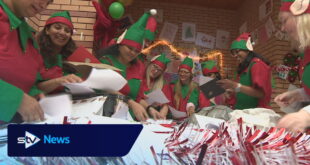Dunkeld Writers Festival is gearing up for its third incarnation this weekend. Passion and hometown pride are the buzzwords for this small community nestled at the southern end of the Grampians in south-west Victoria. As a former regular Melbourne Writers Festival goer who attended the last festival, this writer was not prepared for the seamless presentation of events packed with popular and a few “dark horse” panellists, wonderful morning and afternoon teas, and the prospect of a gala dinner at the local Royal Mail Hotel, where book lovers mingle with writers and the odd Very Important Person.
Hamilton’s Bellcourt Books is also in the mix – providing all the writers’ latest books and the opportunity to talk to those writers and indulge in a book signing or two.
Popular attendees Marieke Hardy and Jason Steger are back this year for the Friday Night Bookclub and other sessions cover a wide variety of topics, including crime, landscape, recipe books and sport.
Bellcourt Books’ Roz Greenwood is not just a book lover, she also appears to be a serious rare book collector with a diverse range of interests, including Oscar Wilde, history, local history, music and cricket. She shakes off this observation, however, as if everyone has such passionate and diverse interests.
‘I always wanted to have a bookshop,’ she says simply, when ArtsHub asks her about her literary passions and continuing participation in the festival.
Greenwood began Bellcourt Books in 1984 in Hamilton and Horsham. She now has Roz Greenwood Old and Rare Books in Dunkeld, an enterprise suggested to her by prominent locals Allan and Maria Myers who believed that having a bookshop in town was very important.
The evolution of the Dunkeld Writers Festival
‘It was the initiative of Mary Ann Brown, Dunkeld local and current councillor for the Southern Grampians Shire,’ explains Greenwood. ‘She headhunted from our good community for people with a bank of skills.’
The event has now developed into something more than just a writers’ festival, she adds.
‘Hospitality is important,’ says Greenwood, adding that the community gets behind the team, and cites the participation of the Dunkeld Refugee and Asylum Seeker Support Group (DRASS) as an example.
Greenwood believes that the Dunkeld Writers Festival is a great way to meet like-minded people. Last year, two popular writers, Marcia Langton and Barry Jones, treated the audience to a conversation and an impromptu reminiscence that was a delight. It would be hard to top having Jones lean over with a loud whisper in the bookshop, recommending a favourite book…
Sitting in Greenwood’s bookshop in a comfy leather armchair, ArtsHub admires the view of Mount Sturgeon rising above the hotel. Greenwood agrees. ‘It is that sense of belonging … those mountains have such a draw,’ she says.
Greenwood has that relaxed and engaging personality that makes visiting her bookshop a delight on a cold winter’s day and the chat with ArtsHub metamorphoses into a long conversation about books, Wagner, Venice and Oscar Wilde.
She talks with great passion about the region’s history and of the great legacy of book collections from farming properties across the south-west. In an earlier discussion Greenwood had talked about the session involving Dr Ruth Pullin and Dr Katherine Kovacic, ‘Our Place, Our Memory’, chaired by Allan Myers KC AC, particularly about Pullin’s project on German-born artist and collector Eugene von Guérard.
Pullin is an art historian and curator with degrees from Monash University, a PhD from the University of Melbourne and an Honorary Fellow in their School of Culture and Communication.
Becoming an art historian
ArtsHub asks Pullin to elaborate on her career path. ‘It was always something that I wanted to do. I loved studying art history at my small country high school, which I did through the Education Department’s Correspondence School. I continued my studies in art history at Monash University alongside careers, first as an English teacher and then in museum education at the National Gallery of Victoria,’ she says.
‘My introduction to the joys of archival research came with a minor thesis on the Italian Baroque painter, Guercino [aka Giovanni Francesco Barbieri]. I completed my PhD at the University of Melbourne, 2007, and the findings of that research informed the National Gallery of Victoria’s 2011 travelling exhibition, Eugene von Guérard: Nature Revealed, of which I was Guest Curator. My research, which has focused on the many dimensions of this artist’s extraordinary life and career, has continued since then.’
Pullin explains to ArtsHub how her session in Dunkeld Writers Festival, ‘Our Landscape, Our Memory’, developed.
Our Landscape, Our Memory
‘I’d like to start by considering the meaning of this landscape for von Guérard, and the idea of “memory”,’ she says.
‘The impact of this landscape – the Gariwerd/Grampians region and the volcanic terrain of south-western Victoria – on von Guérard was powerful and enduring. On his first visit, in August 1855, he scaled Mount Rouse and registered the distinctive profile of the Grampians Range over five continuous pages of his sketchbook. A few days later, he saw his first Western District crater lake, the spectacular Tower Hill. Both became the subjects of major works. This was the first of a series of return visits and the beginning of a deep relationship with this landscape and its people. His story is now woven into the landscape.
‘The theme, “Our Landscape, Our Memory” has a kind of duality when we think about von Guérard,’ she continues. ‘On the one hand his response to this distinctive landscape was informed by memories of Europe. He was acutely alive to its geological significance: he recognised its parallels with the volcanic German Eifel region through which he had travelled in 1843 and he responded to the dramatic profiles of the Gariwerd-Grampians Range as expressions of ancient geological processes – in effect, the history of the earth.
‘While his canvases are filled with lively observations of the present moment – bird life, areas of surface water, varied vegetation and the fall of light and shadow – at the same time they reach deep into the past, to the formation of the physical landscape, to its “memories”… Through the environmental and historical information that they carry, the paintings contribute to a shared “memory” of place and, on a purely visual level, they shape the way we see this landscape.’
Read: 5 tips to maximise your chances of being a guest at writers’ festivals
She adds, ‘von Guérard’s correspondence with the Berlin Ethnological Museum has brought to light another – and intrinsically problematic – dimension, of the artist’s engagement with this landscape and its people. It has long been known that von Guérard accrued a collection of Aboriginal cultural material on his expeditions, and that his collection is now held at the Humboldt Forum in Berlin (the Berlin Ethnological Museum). From the information recorded on the catalogue cards that I had seen in 2001, I was convinced that von Guérard’s collection must have been accompanied by detailed documentation when it arrived in Berlin in 1879. But it was only in 2019 that I learned from Anna Weinreich, now a curator at the Humboldt Forum, that the letters existed.
‘Working from images supplied by Berlin, my colleague, Tom Darragh, and I have translated the letters from the original handwritten “old” German, and we have published them in their entirety. Together, with Tom’s facility with old German, my knowledge of von Guérard (and some German), and our past experience with von Guérard’s distinctive hand, we were able to decipher their content. We felt a kind of responsibility to do it, and to make the content of the letters accessible to the communities for whom it has relevance. My focus in this project has been von Guérard and, in our work, the ancestral cultural belongings of the Gunditjmara and Djab Wurrung people are mentioned only as represented in the correspondence.
‘The letters are important at many levels. In terms of von Guérard’s story, they clarify which items were in his personal collection and which were acquired on consignment for the museum. They record the sites and circumstances of specific acquisitions, these records aligning in revealing ways with his sketchbooks – most notably the book he used on his 1856 expedition from Mount Sturgeon to Mount Zero.
‘They reveal the importance of his friendship with James Dawson and his visits to Kangatong. There, for example, von Guérard watched as a handle was made for a stone axe, recording the name of the maker and describing the materials and techniques involved. And his observations on the creative vision of the Gunditjmara artist, known today only as Johnny Dawson, reveal as much about him as they do about Johnny.
‘I am thrilled that our session will take place below the magnificent Mount Sturgeon, in the heart of the landscape that resonated so deeply for von Guérard – as it has for countless generations here, past and present,’ concludes Pullin
Dunkeld Writers Festival runs 23-25 August 2024 at various venues.
Source link


